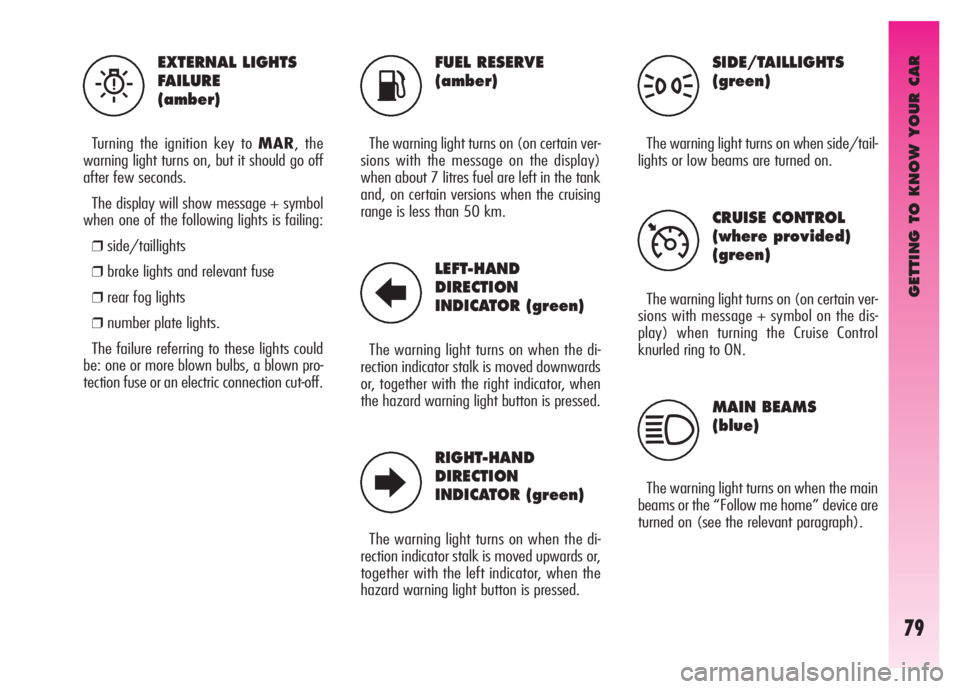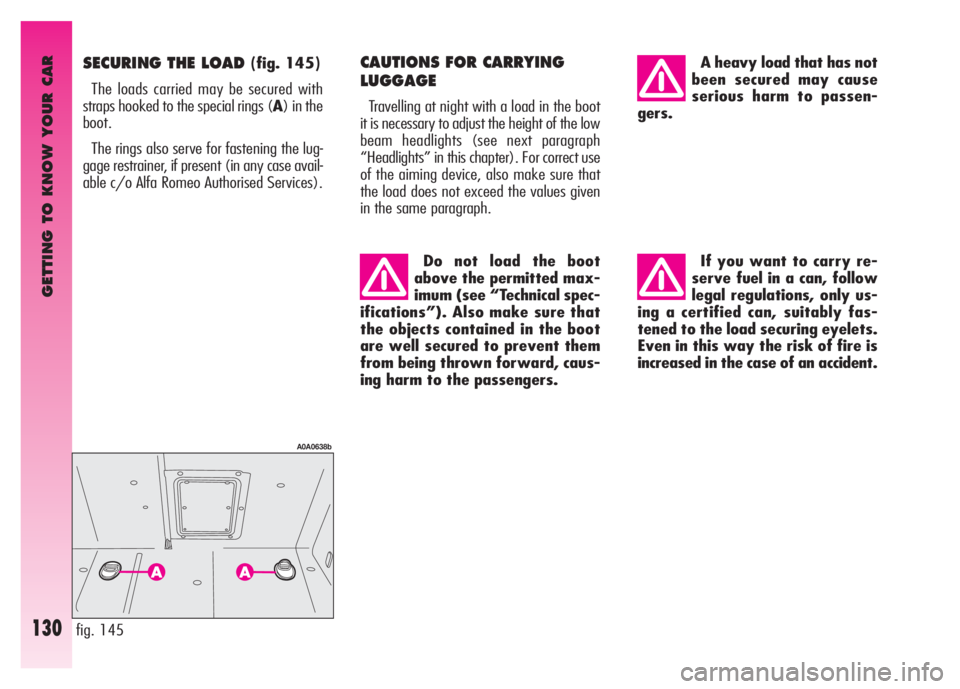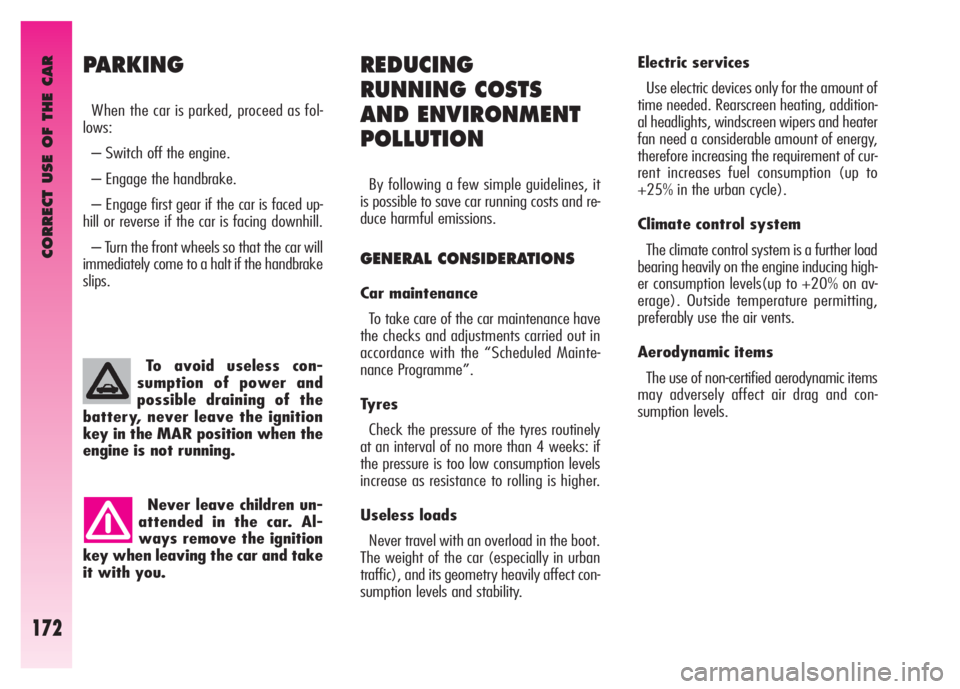fuel Alfa Romeo GT 2008 Owner handbook (in English)
[x] Cancel search | Manufacturer: ALFA ROMEO, Model Year: 2008, Model line: GT, Model: Alfa Romeo GT 2008Pages: 271, PDF Size: 5.57 MB
Page 79 of 271

GETTING TO KNOW YOUR CAR
77
INEFFICIENT ABS
SYSTEM (where
provided) (amber)
Turning the ignition key to MARthe warn-
ing light turns on, but it should go off after
few seconds.
The warning light turns on (together with
message + symbol on the display) when the
system is inefficient. In this case the brak-
ing system keeps its effectiveness un-
changed, but without the potential offered
by the ABS system.
Caution is advisable, particularly in all cas-
es of less than perfect grip. It is necessary
to contact Alfa Romeo Authorized Services
as soon as possible.
INEFFICIENT EBD
ELECTRONIC
BRAKING
DISTRIBUTOR (red)
(amber)
The turning on at the same
time of warning lights
xand>(togeth-
er with message + symbol on the display)
with the engine running indicates an EBD
system failure; in this case heavy braking
may cause the rear wheels to lock before
time, with the possibility of skidding.
Drive with the utmost care to the nearest
Alfa Romeo Authorized Service to have the
system checked.
INERTIAL FUEL
CUT-OFF SWITCH
Message + symbol are displayed when the
inertial fuel cut-off switch is triggered.
s>x
>
If after the message you
smell fuel or see leaks from
the fuel system, do not re-
set the switch to avoid fire risk.
Page 81 of 271

GETTING TO KNOW YOUR CAR
79
FUEL RESERVE
(amber)
The warning light turns on (on certain ver-
sions with the message on the display)
when about 7 litres fuel are left in the tank
and, on certain versions when the cruising
range is less than 50 km.
LEFT-HAND
DIRECTION
INDICATOR (green)
The warning light turns on when the di-
rection indicator stalk is moved downwards
or, together with the right indicator, when
the hazard warning light button is pressed.
RIGHT-HAND
DIRECTION
INDICATOR (green)
The warning light turns on when the di-
rection indicator stalk is moved upwards or,
together with the left indicator, when the
hazard warning light button is pressed.
SIDE/TAILLIGHTS
(green)
The warning light turns on when side/tail-
lights or low beams are turned on.
CRUISE CONTROL
(where provided)
(green)
The warning light turns on (on certain ver-
sions with message + symbol on the dis-
play) when turning the Cruise Control
knurled ring to ON.
MAIN BEAMS
(blue)
The warning light turns on when the main
beams or the “Follow me home” device are
turned on (see the relevant paragraph).
EXTERNAL LIGHTS
FAILURE
(amber)
Turning the ignition key to MAR, the
warning light turns on, but it should go off
after few seconds.
The display will show message + symbol
when one of the following lights is failing:
❒side/taillights
❒brake lights and relevant fuse
❒rear fog lights
❒number plate lights.
The failure referring to these lights could
be: one or more blown bulbs, a blown pro-
tection fuse or an electric connection cut-off.
WK
R
E
3
Ü
1
Page 109 of 271

GETTING TO KNOW YOUR CAR
107
If no leaks are found the car can be restart-
ed. Press button (A) to activate the fuel sup-
ply system again.
fig. 113
A0A0092b
If a smell of fuel is noted
following an accident, or
the fuel system is leaking,
to avoid the risk of fire do not re-
set the switch. DOOR LOCKING SYSTEM
(fig. 112)
To lock the doors simultaneously, press but-
ton (E), on the centre console panel, re-
gardless of the position of the ignition key.
The deterrent led turns on as follows:
– with the ignition key at MARglowing
steadily with a yellow light;
– with the ignition key at STOPflash-
ing with a red light (deterrence condition).
INERTIAL FUEL CUT-OFF
SWITCH
(fig. 113)
This is an automatic safety switch, to be
found on the floor next to the driver’s door
pillar, which is triggered in the event of a
crash of a certain magnitude to interrupt the
flow of fuel.
The cutting in of the inertial switch is shown
on the display of the instrument cluster.
Page 132 of 271

GETTING TO KNOW YOUR CAR
130
Do not load the boot
above the permitted max-
imum (see “Technical spec-
ifications”). Also make sure that
the objects contained in the boot
are well secured to prevent them
from being thrown forward, caus-
ing harm to the passengers.
A heavy load that has not
been secured may cause
serious harm to passen-
gers.
If you want to carry re-
serve fuel in a can, follow
legal regulations, only us-
ing a certified can, suitably fas-
tened to the load securing eyelets.
Even in this way the risk of fire is
increased in the case of an accident.
SECURING THE LOAD (fig. 145)
The loads carried may be secured with
straps hooked to the special rings (A) in the
boot.
The rings also serve for fastening the lug-
gage restrainer, if present (in any case avail-
able c/o Alfa Romeo Authorised Services). CAUTIONS FOR CARRYING
LUGGAGE
Travelling at night with a load in the boot
it is necessary to adjust the height of the low
beam headlights (see next paragraph
“Headlights” in this chapter). For correct use
of the aiming device, also make sure that
the load does not exceed the values given
in the same paragraph.
fig. 145
A0A0638b
Page 167 of 271

GETTING TO KNOW YOUR CAR
165
DIESEL ENGINES
If the outside temperature is very low, the
diesel thickens due to the formation of paraf-
fins and could clog the diesel fuel filter.
In order to avoid these problems, different
types of diesel are distributed according to
the season: summer type, winter type arc-
tic type (mountains/cold areas).
If refuelling with diesel fuel not suitable for
the current temperature, mix diesel fuel with
TUTELA DIESEL ARTadditive in the pro-
portions stated on the can, putting first the
antifreeze in the tank and then the diesel
fuel.
TUTELA DIESEL ARTshall be added to
diesel fuel before the due to cold take place.
Adding it later will be worthless. If driving or
parking the vehicle for a long period in cold
areas/mountains, refuel with the diesel fu-
el available at local filling stations. In this
situation you are also recommended to have
in the tank an amount of fuel 50% higher
than usable capacity.
REFUELLING
PETROL ENGINES
Use only unleaded petrol.
To prevent accidentally filling with leaded
petrol, the diameter of the fuel tank filler
is of such a size as not to accept the noz-
zle of this type of petrol.
The unleaded petrol octane number
(R.O.N.) used shall not be less than 95.
IMPORTANTAn inefficient catalyst
leads to harmful emission at the exhaust,
thus environment pollution.
IMPORTANTUnder no circumstances
should conventional leaded petrol be used,
as this would irreparably damage the cata-
lyst.Cars with diesel engines
must only be filled with
diesel fuel for motor vehi-
cles, in compliance with European
Specification EN590. The use of
other products or mixtures may ir-
reparably damage the engine with
invalidation of the warranty due to
the damage caused. In the event of
accidentally filling with another
type of fuel, do not start the en-
gine and empty the tank. If the en-
gine has been run even for only a
very short time, in addition to the
tank, it is also necessary to drain
out the whole fuel circuit.
Page 168 of 271

GETTING TO KNOW YOUR CAR
166
IMPORTANTThe sealing of the tank
may cause light pressurising in the tank. A
little breathing off, while slackening the cap,
is absolutely normal.
After refuelling, turn the cap clockwise and
close the flap.
IMPORTANTFor your safety, make sure
that the fuelling pump nozzle is inserted cor-
rectly into the housing, before starting the
engine.Should it be not possible to open the fuel
flap electrically, use the special cable in the
boot (A-fig. 156) to open it manually. FUEL CAP
The fuel cap (C-fig. 154) is electrically
controlled. To open it, press button (D-fig.
155); the flap can be opened only when
the engine is off.
The fuel cap (A-fig. 154), accessible af-
ter opening the lid (C), is fitted with a catch
to prevent losing it (B) which fastens it to
the lid.
When refuelling, hook the cap to the de-
vice on the inner flap, as illustrated.
Do not put naked flames
or lighted cigarettes near
the fuel filler hole as there
is a danger of fire. Do not bend too
close to the hole either so as not to
breathe in harmful vapours.
If required, replace the fu-
el cap only with a genuine
new one to prevent im-
pairing the petrol vapour system.
fig. 154
A0A0644b
fig. 155
A0A1108b
fig. 156
A0A0652b
Page 169 of 271

GETTING TO KNOW YOUR CAR
167
The devices used to reduce diesel fuel en-
gine emissions are:
– oxidising catalyst;
– exhaust gas recirculation system (E. G. R.);
– diesel particulate filter (DPF). DPF (Diesel Particulate Filter)
(for versions/ markets where
applicable)
The Diesel Particulate Filter is a mechani-
cal filter, integral with the exhaust system,
that physically traps particulates present in
the exhaust gases of Diesel engines.
The diesel particular filter has been adopt-
ed to eliminate almost totally particulates in
compliance with current / future law regu-
lations.
During normal use of the car, the engine
control unit records a set of data (e.g.: trav-
el time, type of route, temperatures, etc.)
and it will then calculate how much partic-
ulates has been trapped by the filter.
Since this filter physically traps particulates,
it shall be cleaned (reclaimed) at regular in-
tervals by burning carbon particles.
ENVIRONMENTAL
PROTECTION
The devices used to reduce petrol engine
emissions are:
– trivalent catalytic converter (catalytic si-
lencer);
– Lambda sensors;
– anti-evaporation system.
If one or more spark plugs are discon-
nected, do not run the engine, even for a
test.During normal service the
catalyst and the diesel par-
ticulate filter (DPF) reach
high temperatures. Do not there-
fore park the car over inflammable
materials (grass, dry leaves, pine
needles, etc.): fire hazard.
Page 173 of 271

CORRECT USE OF THE CAR
171
Never push, tow or coast
start the car. This could
cause fuel to flow into the
catalyst damaging it irreversibly.
Remember that the en-
gine brake and power
steering are not opera-
tional until the engine is started,
therefore, much greater effort than
usual is needed on the brake ped-
al and steering wheel. For cars with turbocharg-
er in particular, but for all
cars in general, sharp ac-
celerating should be avoided before
switching the engine off.
A “kick” on the accelerator
serves no purpose, consumes fuel
pointlessly and may cause serious
damage to the turbocharger im-
peller bearings.
EMERGENCY STARTING
If the Alfa Romeo CODE system does not
recognise the code transmitted by the igni-
tion key (warning light
Yon the instru-
ment cluster glowing on steadily) emer-
gency starting may be carried out using the
code of the CODE card.
For the correct procedure see the chapter
“In an emergency”.
IMPORTANTIf the engine turns off with
the car on the move, the next time it is start-
ed, the Alfa Romeo CODE warning light may
turn on(
Y). In this case, check that switch-
ing off and starting the engine again with
the car stationary, the warning light stays
off. If not, contact Alfa Romeo Authorised
Services.
ENGINE SWITCHING OFF
– Release the accelerator pedal and wait
until the engine reaches idle speed.
– Turn the ignition key to the STOPpo-
sition and switch off the engine.
IMPORTANTAfter a tiring journey it is
advisable to let the engine “get its breath
back” allowing it to idle a while to lower the
temperature in the engine compartment.
Page 174 of 271

CORRECT USE OF THE CAR
172
Never leave children un-
attended in the car. Al-
ways remove the ignition
key when leaving the car and take
it with you.To avoid useless con-
sumption of power and
possible draining of the
battery, never leave the ignition
key in the MAR position when the
engine is not running.
PARKING
When the car is parked, proceed as fol-
lows:
– Switch off the engine.
– Engage the handbrake.
– Engage first gear if the car is faced up-
hill or reverse if the car is facing downhill.
– Turn the front wheels so that the car will
immediately come to a halt if the handbrake
slips.
REDUCING
RUNNING COSTS
AND ENVIRONMENT
POLLUTION
By following a few simple guidelines, it
is possible to save car running costs and re-
duce harmful emissions.
GENERAL CONSIDERATIONS
Car maintenance
To take care of the car maintenance have
the checks and adjustments carried out in
accordance with the “Scheduled Mainte-
nance Programme”.
Tyres
Check the pressure of the tyres routinely
at an interval of no more than 4 weeks: if
the pressure is too low consumption levels
increase as resistance to rolling is higher.
Useless loads
Never travel with an overload in the boot.
The weight of the car (especially in urban
traffic), and its geometry heavily affect con-
sumption levels and stability.Electric services
Use electric devices only for the amount of
time needed. Rearscreen heating, addition-
al headlights, windscreen wipers and heater
fan need a considerable amount of energy,
therefore increasing the requirement of cur-
rent increases fuel consumption (up to
+25% in the urban cycle).
Climate control system
The climate control system is a further load
bearing heavily on the engine inducing high-
er consumption levels(up to +20% on av-
erage). Outside temperature permitting,
preferably use the air vents.
Aerodynamic items
The use of non-certified aerodynamic items
may adversely affect air drag and con-
sumption levels.
Page 175 of 271

CORRECT USE OF THE CAR
173
CONDITIONS OF USE
Cold starting
Short journeys and frequent cold starts do
not allow the engine to reach optimum op-
erating temperature. This results in a sig-
nificant increase in consumption levels (from
+15 to +30% on the urban cycle) and emis-
sion of harmful substances.
Traffic situations and road
conditions
Rather high consumption levels are tied to
situations with heavy traffic, for example
in queues with frequent use of the lower
gears or in cities with many traffic lights. Al-
so winding mounting roads and rough road
surfaces adversely affect consumption.
Stopping in the traffic
During prolonged stops (e.g. level cross-
ings) it is advisable to switch the engine off.
DRIVING STYLE
Starting
Do not warm the engine with the car at a
standstill or at idle or high speed: under
these conditions the engine warms up much
more slowly, increasing electrical consump-
tion and emissions. It is therefore advisable
to move off immediately, slowly, avoiding
high speeds. This way the engine will warm
faster.
Pointless manoeuvres
Avoid accelerating when waiting at traffic
lights or before switching off the engine. This
and also double declutching is absolutely
pointless on modern cars and also increase
consumption and pollution.
Gearshifting
As soon as the conditions of the traffic and
road allow, use a higher gear.
Using a low gear to obtain brilliant per-
formance increases consumption.
In the same way improper use of a high
gear increases consumption, emissions and
engine wear.Top speed
Fuel consumption considerably increases
with speed. Maintain an even as possible
speed, avoiding superfluous braking and ac-
celerating, which cost in terms of both fuel
and emissions.
Acceleration
Accelerating heavily taking the engine to
a high speed has a considerably adverse ef-
fect on consumption and emission levels;
it is wise to accelerate gradually and not ex-
ceed the maximum torque.